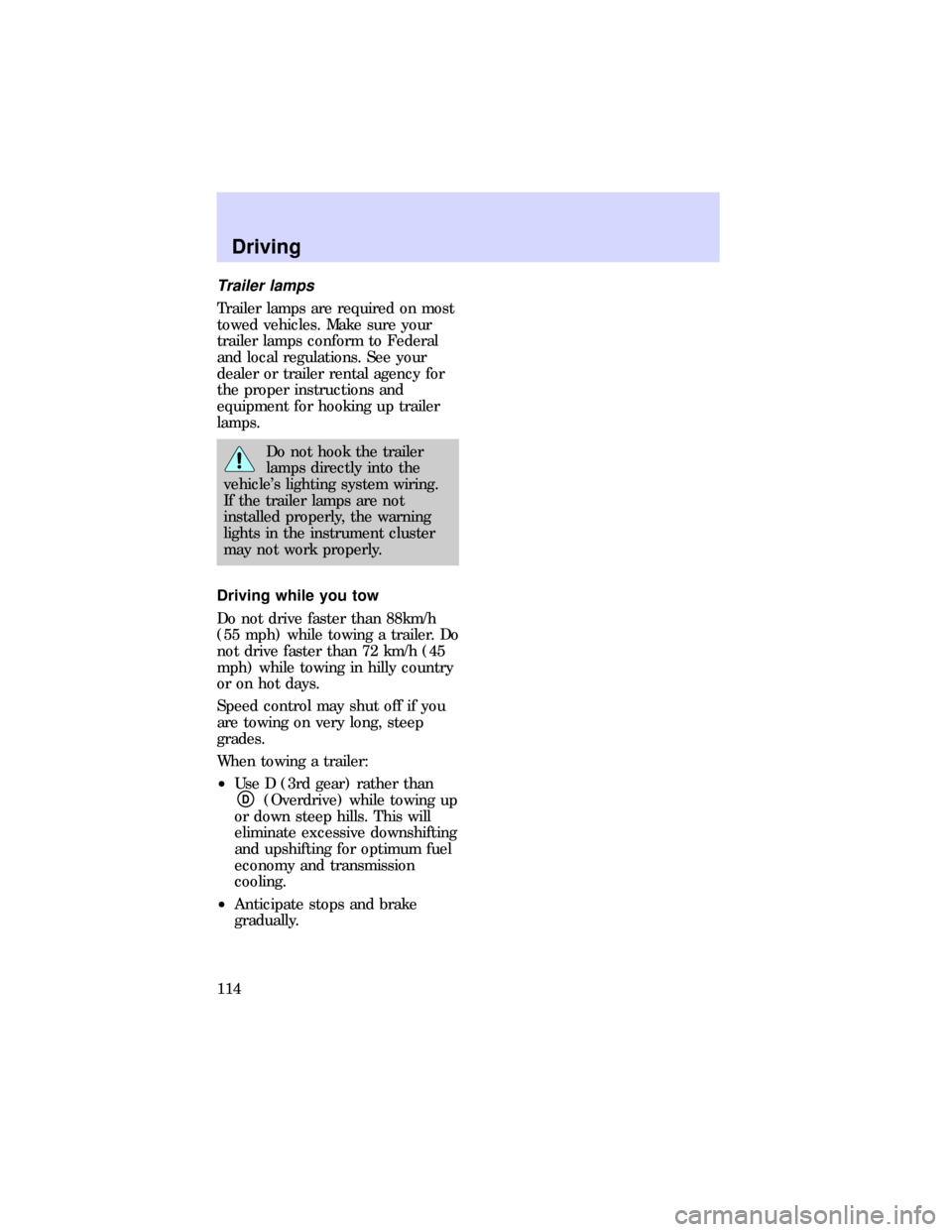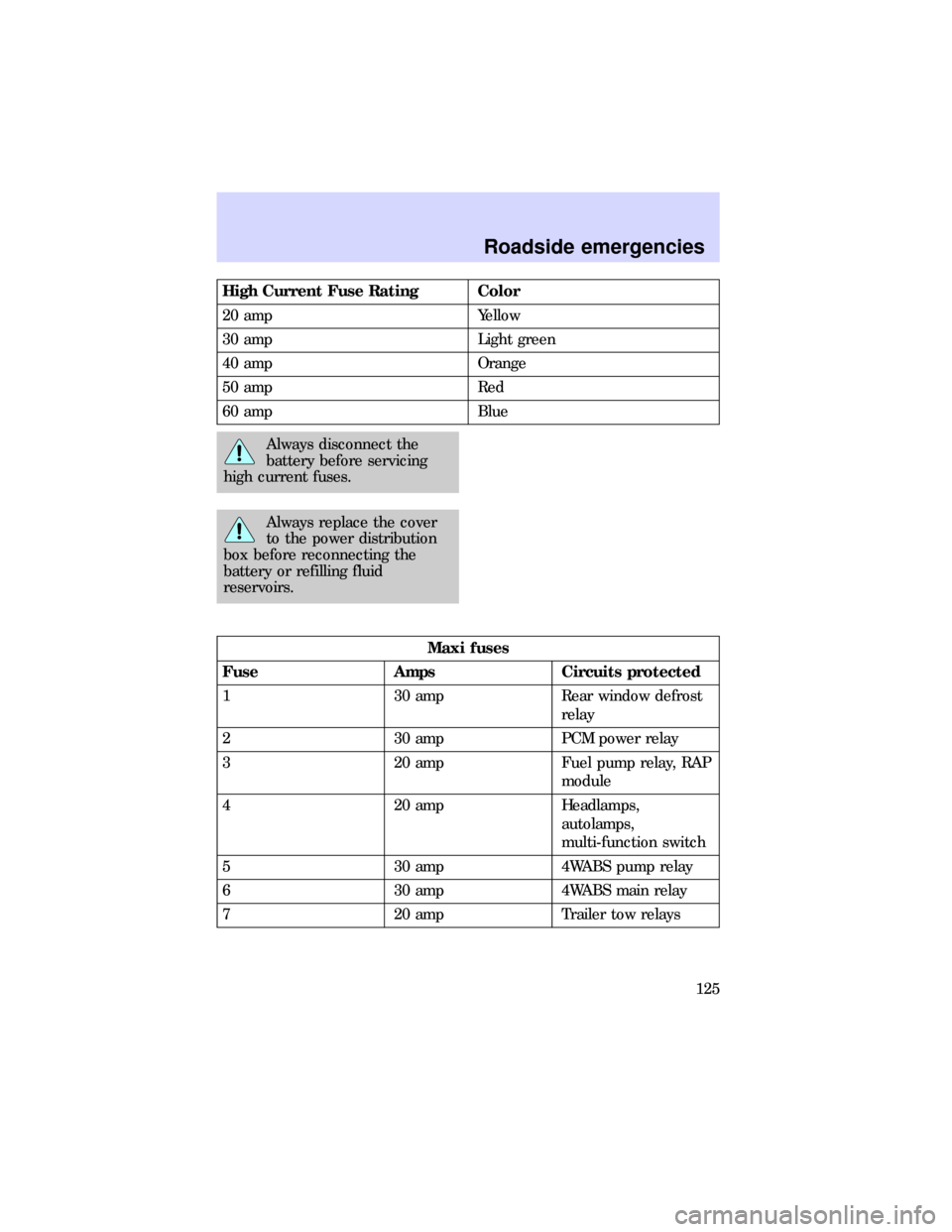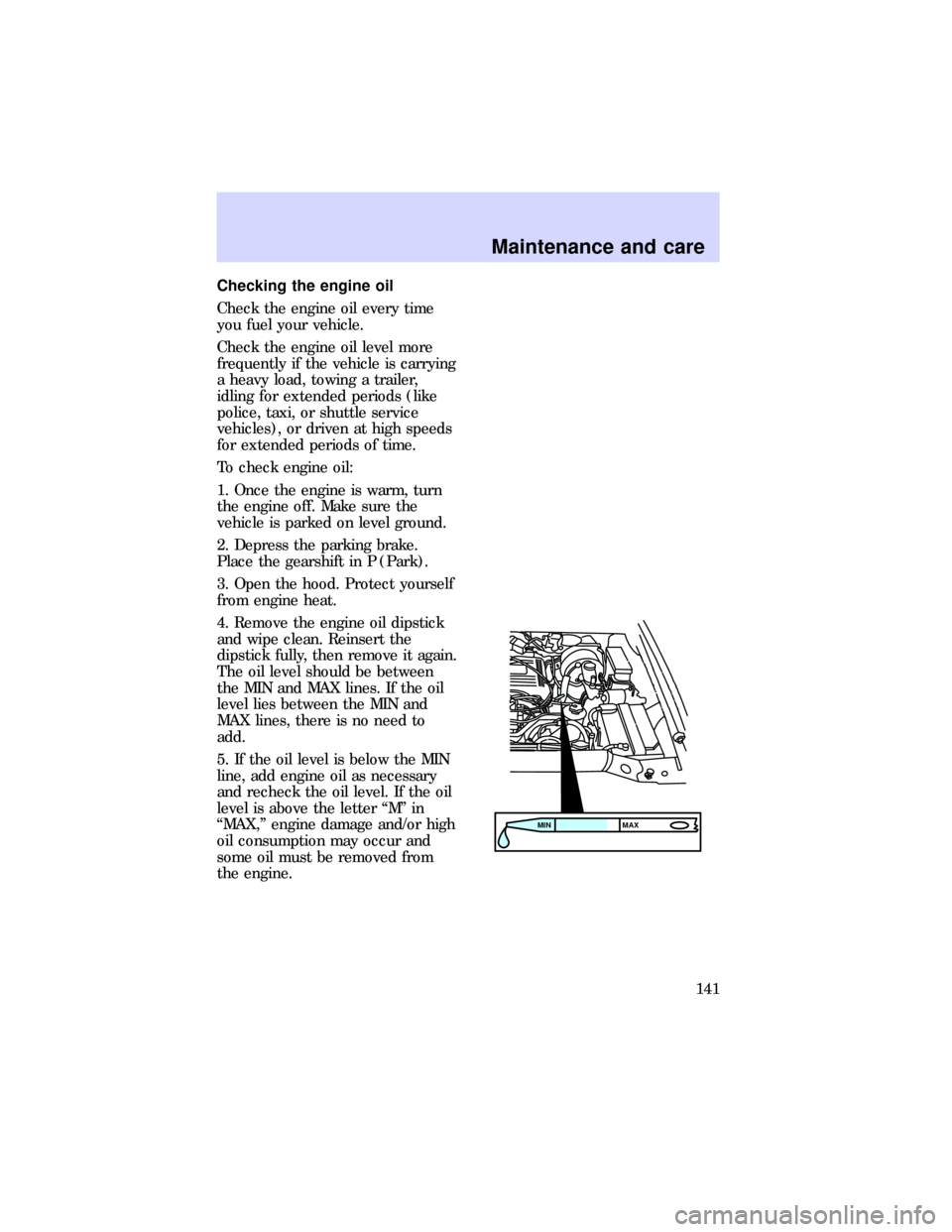tow Mercury Mountaineer 1997 s Owner's Guide
[x] Cancel search | Manufacturer: MERCURY, Model Year: 1997, Model line: Mountaineer, Model: Mercury Mountaineer 1997Pages: 197, PDF Size: 2.08 MB
Page 113 of 197

bumper has a Class II rating (1590
kg/3500 lb trailer weight and 159
kg/350 lb tongue weight).
Safety chains
Always connect the trailer's safety
chains to the vehicle. To connect
chains when towing with the step
bumper, cross the chains under the
trailer tongue and allow slack for
turning corners. Connect the
chains to the holes in the
underside of the hitch plate for a
Class II frame mounted hitch.
When using a frame mounted
trailer hitch, attach the safety
chains to the frame mounted hitch
using the recommendations
supplied by the hitch
manufacturer.
Trailer brakes
Trailer brakes are required on
most towed vehicles weighing over
680 kg/ 1500 lb. Use electric
brakes or manual, automatic, or
surge-type hydraulic brakes that
meet Federal and local regulations.
Install and adjust the brakes
according to the manufacturer's
instructions.
Do not connect a trailer's
hydraulic brake system
directly to your vehicle's brake
system. Your vehicle may not
have enough braking power and
your chances of having a
collision greatly increase.
Driving
113
Page 114 of 197

Trailer lamps
Trailer lamps are required on most
towed vehicles. Make sure your
trailer lamps conform to Federal
and local regulations. See your
dealer or trailer rental agency for
the proper instructions and
equipment for hooking up trailer
lamps.
Do not hook the trailer
lamps directly into the
vehicle's lighting system wiring.
If the trailer lamps are not
installed properly, the warning
lights in the instrument cluster
may not work properly.
Driving while you tow
Do not drive faster than 88km/h
(55 mph) while towing a trailer. Do
not drive faster than 72 km/h (45
mph) while towing in hilly country
or on hot days.
Speed control may shut off if you
are towing on very long, steep
grades.
When towing a trailer:
²Use D (3rd gear) rather than
D(Overdrive) while towing up
or down steep hills. This will
eliminate excessive downshifting
and upshifting for optimum fuel
economy and transmission
cooling.
²Anticipate stops and brake
gradually.
Driving
114
Page 115 of 197

Servicing while towing
If you tow a trailer for long
distances, your vehicle will require
more frequent service intervals.
Refer to theService Guidefor
more information.
Trailer towing
²Practice turning, stopping and
backing in an area before
starting on a trip to get the feel
of the vehicle/trailer
combination. When turning,
drive slightly beyond the normal
turning point so the trailer
wheels will clear curbs and
other obstacles.
²Allow more room for stopping
with a trailer attached.
²The trailer tongue weight should
be 10-15% of the loaded trailer
weight for a Class I or II rear
bumper hitch.
²After you have travelled about
80 km (50 miles), thoroughly
check your hitch, electrical
connections and trailer wheel
lug nuts.
²When stopped in traffic for long
periods of time in hot weather,
place the gearshift in P (Park)
to increase idle speed. This aids
engine cooling and air
conditioner efficiency.
²Vehicles with trailers should not
be parked on a grade. If you
must park on a grade, place
wheel chocks under the trailer's
wheels.
Driving
115
Page 118 of 197

HAZARD SWITCH
Use the hazard flashers to warn
traffic of vehicle problems.
Press button down to activate
hazard flashers.
Press button again to deactivate
hazard flashers.
FUEL PUMP SHUTOFF SWITCH
The fuel pump shutoff switch stops
the fuel pump when the vehicle
has been involved in a collision or
major jolt. If the vehicle does not
start, it is possible that the fuel
pump shutoff switch needs to be
reset.
If you see or smell fuel, do
not reset the switch or try
to start your vehicle. Have all the
passengers get out of the vehicle
and call the local fire department
or a towing service.
0P RND21
UNLEADED
FUEL ONLY
RPM x 100012345
6H
C
F
E
RSM
SET
ACC
COAST OFF ON
SRS
- +H
H
L L020
1030405060
70
80
90
110
120000000oooo
km/h100
20406080100
120
140
160
180
Roadside emergencies
118
Page 124 of 197

Power distribution box
Lift cover towards front of vehicle
to access the power distribution
box.
The high-current fuses in the
power distribution box protect
your vehicle's main electrical
systems from overloads. The high
current fuses are coded as follows:
14 13
12 11
10 9
87
65
43
2
8
47
36
25
1
11 10 9
1
Roadside emergencies
124
Page 125 of 197

High Current Fuse Rating Color
20 amp Yellow
30 amp Light green
40 amp Orange
50 amp Red
60 amp Blue
Always disconnect the
battery before servicing
high current fuses.
Always replace the cover
to the power distribution
box before reconnecting the
battery or refilling fluid
reservoirs.
Maxi fuses
Fuse Amps Circuits protected
1 30 amp Rear window defrost
relay
2 30 amp PCM power relay
3 20 amp Fuel pump relay, RAP
module
4 20 amp Headlamps,
autolamps,
multi-function switch
5 30 amp 4WABS pump relay
6 30 amp 4WABS main relay
7 20 amp Trailer tow relays
Roadside emergencies
125
Page 131 of 197

Position the jack under the rear
axle to raise the rear wheel.
14. Turn the jack handle clockwise
and raise the vehicle until the tire
just clears the ground.
15. Remove the wheel lug nuts and
flat tire, and install the spare.
16. Install the lug nuts and tighten
until snug.
Use of wheel or lug nuts
other than original
equipment could cause damage
to the wheel or mounting system
and allow the wheels to come off
while the vehicle is in motion.
17. Lower the vehicle and tighten
the wheel lug nuts as shown.
18. Unblock the wheels and put
the flat tire, jack, jack handle and
lug wrench away.
Stowing flat tires
Stow aluminum wheel and tire
with valve stem down.
1
4
2
5 3
Roadside emergencies
131
Page 132 of 197

To stow largest flat tire, place
inside vehicle and secure with
webbing retainer.
JUMP STARTING A DISABLED
VEHICLE
The gases around the
battery can explode if
exposed to flames, sparks, or lit
cigarettes. An explosion could
result in injury or vehicle
damage.
To protect yourself when
charging a battery, always
shield your face and eyes. Make
sure that you can breath fresh
air.
Batteries contain sulfuric
acid which burns skin,
eyes and clothing.
If the acid touches someone's skin,
eyes, or clothing, immediately flush
the area with water for at least 15
minutes. If someone swallows the
acid, have him or her drink lots of
milk or water first, then Milk of
Magnesia, a beaten egg, or
Roadside emergencies
132
Page 135 of 197

WRECKER TOWING
It is recommended that your
vehicle be towed with wheel lift
and dollies or flatbed equipment.
Do not tow with slingbelt
equipment. Ford Motor Company
has not developed or approved a
T-hook or slingbelt towing
procedure.
Roadside emergencies
135
Page 141 of 197

Checking the engine oil
Check the engine oil every time
you fuel your vehicle.
Check the engine oil level more
frequently if the vehicle is carrying
a heavy load, towing a trailer,
idling for extended periods (like
police, taxi, or shuttle service
vehicles), or driven at high speeds
for extended periods of time.
To check engine oil:
1. Once the engine is warm, turn
the engine off. Make sure the
vehicle is parked on level ground.
2. Depress the parking brake.
Place the gearshift in P (Park).
3. Open the hood. Protect yourself
from engine heat.
4. Remove the engine oil dipstick
and wipe clean. Reinsert the
dipstick fully, then remove it again.
The oil level should be between
the MIN and MAX lines. If the oil
level lies between the MIN and
MAX lines, there is no need to
add.
5. If the oil level is below the MIN
line, add engine oil as necessary
and recheck the oil level. If the oil
level is above the letter ``M'' in
``MAX,'' engine damage and/or high
oil consumption may occur and
some oil must be removed from
the engine.
MAX MIN
Maintenance and care
141